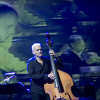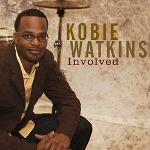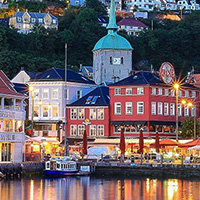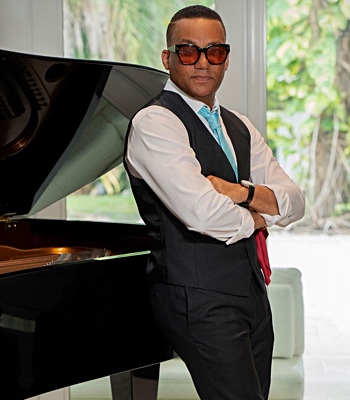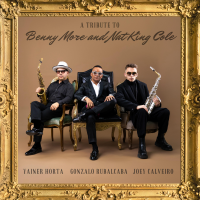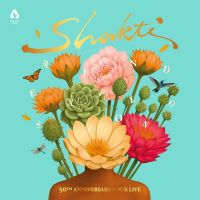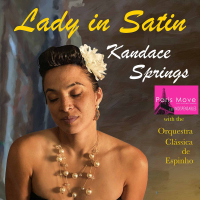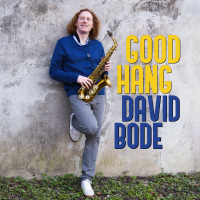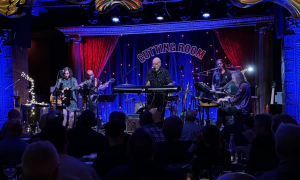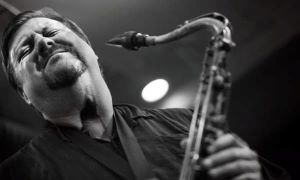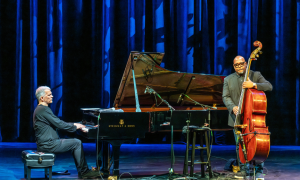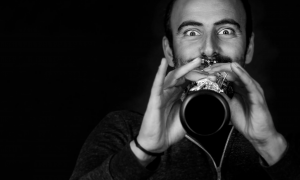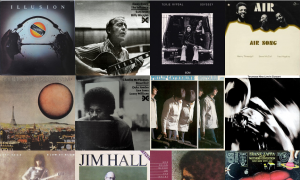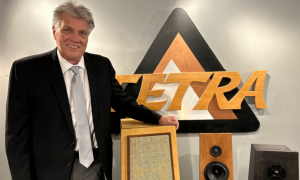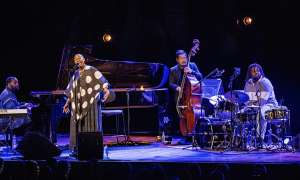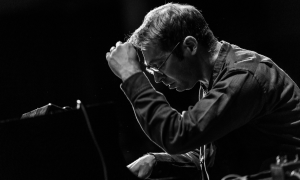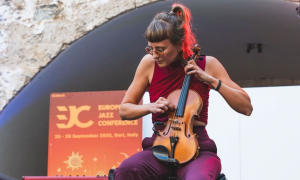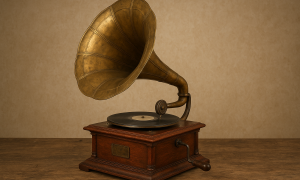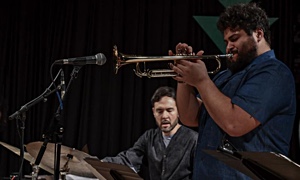Home » Jazz Articles » Live Review » Punkt Festival 2009: Day 2, Kristiansand, Norway, Septem...
Punkt Festival 2009: Day 2, Kristiansand, Norway, September 3, 2009
One of Punkt's many definers is its fearless avoidance of stylistic boundaries. Some festivals are expanding their stylistic purview out of necessity; Punkt has always been style-blind by definition. So it's not uncommon to find a program where some of today's greatest experimentalists not only share the same bill as a soulful, pop-ready singer/songwriter, but share the same audience as well. Because Punkt audiences—at least the many who, after experiencing the festival once, now make it an unmissable annual event—are as much a part of the festival as the people who work year-round to organize it, and the artists who participate at it.

It's about a sense of family, and returning to Kristiansand becomes more like pilgrimage and a family reunion revolving around four days of music, rather than simply attending a music festival. Barriers between fans, media, organizers/volunteers and artists are as much dissolved as musical ones, as they comingle in the very short breaks between performances and remixes, or at the festival hotel, where an included breakfast buffet provides the perfect opportunity to meet friends from past years and catch up.
Day Two of Punkt 2009 was its first for regular programming at the Agder Theatre. A 550-seat venue is used for the main performances, while the Alpha Room, at about half that capacity, is used for the live remixes. One features integrated set design and lighting/visuals, thanks to Tord Knutsen and Jan Martin Vågan—remarkable for their depth and complexity, especially considering how little time there is between shows (no more than an hour)—while the other is as spare as can be because, after all, it's impossible to create a set design around music that's yet to be defined, let alone made.
Chapter Index
- Adam Rudolph's Go: Organic Orchestra
- Lab Field / Kim Myhr and Sébastien Roux
- Sidsel Endresen / Maja Ratkje
- Live Remix: Sidsel Endresen, Jan Bang, Erik Honoré
- Jarle Bernhoft
- Live Remix: Mungolian Jet Set Featuring BJ Cole, Jan Bang and Erik Honoré
Adam Rudolph's Go: Organic Orchestra
It's remarkable enough that a town the size of Kristiansand (approximately 75,000) has the kind of culture it does; it's even more remarkable that it has a music conservatory that attracts students from around the country. It's most remarkable, then, that for Punkt 2009's opening performance, American percussionist/composer Adam Rudolph was able to recruit nearly 30 students to perform his unorthodox music for what he calls the Go: Organic Orchestra. Rudolph's hour-long show was all culled from only a few pages of written music; a composition that is far from conventional western notation and where, as conductor for the orchestra, Rudolph is truly shaping music that may have markers from performance to performance, but equally never sounds even close to the same way twice.

This was challenging music for which the title Go: Organic couldn't have been more thoughtfully chosen. Improvisation was a large part of the music, which drew on a multitude of cultural and stylistic forms. There were unmistakable traces of western classicism mixed in with Indian polyrhythms and microtonality, and irregularly metered but visceral grooves with South American rhythmic references commingling with melodic ideas that sounded, at times, more like snippets of conversation than traditional melody. And yet, a seemingly endless number of global references came together in a natural and, well, organic fashion.
Convention was also tossed out when it came to instrumentation. Yes, there were saxophones, trumpets, flutes, clarinets, piano, guitar, bass, drums, percussion and strings. But there was also a three-part vocal section; a collection of Indian instrumentalists on the floor, front stage right, playing tabla, sitar and singing; and, of course, the electronics and live sampling that are so much a part of this festival that it's almost a part of the furniture. Together, the group, which also featured some specially invited guests, navigated Rudolph's multi-movement suite, which often reached into a kind of controlled chaos to ultimately emerge with a strong pulse. There were brief features for some of the orchestra's members that transcended typical solo spots to become more like collective free play, where brief moments in the spotlight were carefully orchestrated by Rudolph.
There were dynamic ebbs and flows, as well as beautifully layered combinations of sweeping strings, individual, wordless vocal explorations, and only the occasional reference to the jazz vernacular. To call this music jazz would be to unfairly limit its reach; there were unmistakable moments where the tradition emerged out of Rudolph's cross-cultural, cross-stylistic mélange. Rudolph has been honing this personal approach to music for some time now, but the fact that he was able to whip a largely student ensemble into world class shape with but a single day's rehearsal is testament to the strength of his concept and his abilities as a master communicator and leader. Watching him conduct the orchestra, it was clear he was an equal participant—not just compositionally, but as an ongoing shaper of how the music came together and how it developed.
Lab Field / Kim Myhr and Sébastien Roux
Turning to the more obliquely experimental, the first of a number of Punkt double-bills featured fearless improvising duo Lab Field, as well as the ongoing partnership of Norwegian guitarist/sound sculptor Kim Myhr and French electronics soundscapist Sébastien Roux.

Punkt's set designs and lighting are always carefully considered with the artists in mind, and the visuals for the two duos was almost diametrically opposed; for Lab Field's 30-minute improvisation, it was a complex mix of mathematical forms that interlaced and interacted, much as the music of percussionist Ingar Zach, also a member of Huntsville, and guitarist David Stacknäs did. Zach's main instrument is a large bass drum standing horizontally rather than vertically, a serendipitous synchronicity with the music Lab Field makes, which is also horizontal, rather than vertical, in nature; broad washes of harmonics and overtones that develop linearly over time rather than in a stacked fashion where harmony creates more defined movement.
Stacknäs' prepared acoustic guitar was also uncharacteristically horizontal, laid out on a table with a variety of processing effects. Resorting to a variety of unorthodox techniques that included bowing the strings, it was rare to hear a sound anywhere resembling guitar; of course, the same could be said for Zach, who would trigger small mechanical devices on the large skin of the bass drum, and allow the vibrations they created to evoke random but still determined sounds from the instrument that largely eschewed any kind of pulse. Instead, both Zach and Stacknäs dispensed, for the most part, with the conventional uses of their instruments and, instead, used them as nothing more than sonic controllers.
Zach could also be seen using a bow to create sharp but musical tones from small bells, but also from a piece of stone; for this intrepid duo, music could be sourced from almost anything. Largely driven by a simple looped beat that was dominant initially but, as the duo's aural landscape became denser, melded into the background, Lab Field's music may have been free, and may have eschewed conventional constructs of rhythm, harmony and melody, but the overall music was still surprisingly beautiful. It was a set as much to be experienced in context of the complex, shifting visuals as heard on its own.

The transition, onstage, between Lab Field and the duo of Myhr and Roux, was quite something to see, as the two risers with Zach and Stacknäs' gear were quickly pushed to the back of the stage, behind projection screens, and replaced with two tables facing each other, with Myhr and Roux's mad scientist rigs of guitars, effects, computers, toys and more. Starkly designed, in comparison to Lab Field's more complex arrangement, this duo didn't build into its music gradually, as Lab Field did. Instead, it hit the ground running, with a flurry of rhythmic activity creating an unsettled feeling from the get-go.
With lighting that was more direct and less detailed, the duo's improvised set managed to move from scuttling chaos to more spacious beauty, especially when Myhr picked up a classical guitar and began to create abstrusely beautiful voicings that warmly filled the entire theatre. Still, while there was a certain introspective nature to the duo's work, there were a number of seeming non sequiturs, where harsh sonics would be briefly introduced, almost as punctuation marks. Bowed wood juxtaposed with more electronic wizardry to create a freely created soundscape concept that was vastly different to that of Lab Field, and proof positive that free improvisation—electronic or otherwise—has potential as broad as the imagination.
Just when it appeared the set was over, with Myhr gradually fading on his guitar, Roux introduced more dominant electronics that clearly drove the final part of the improv in other directions. It was a sign of the give-and-take that may make this kind of music not for the faint-at-heart but, still, an evocative blend that possessed its own appeal that, like Lab Field, was more to be felt than heard.
Sidsel Endresen / Maja Ratkje
For its second double-bill of the evening, Punkt combined two vocalists, both tremendous innovators who work in the world of experimental electronic improvisation, but with a very key difference. Sidsel Endresen, truly one of the most imaginative singers around, relied on nothing more than her voice; Maja Ratkje, on the other hand, possesses a no less distinctive approach, but also utilizes a large array of computers, effects and sampling gear to create a much broader landscape.
 Musical evolution is often about honing an idea and plateauing out, then finding a new concept and making another leap forward. There's been significant change between Endresen from only a few months back, during her brief duet appearance with Håkon Kornstad, and where she is today. Her unique ability to create sounds the human voice shouldn't rightfully be able to make has evolved considerably. In the first of a number of shorter improvisations, she defied reality by creating both the sound of wind and melody simultaneously. Endersen may have been developing vocal techniques that stray far from the lyrical in recent years, but she still possesses a vividly evocative voice capable of rich melodism, and she now seems to be finding a more equitable balance between the two.
Musical evolution is often about honing an idea and plateauing out, then finding a new concept and making another leap forward. There's been significant change between Endresen from only a few months back, during her brief duet appearance with Håkon Kornstad, and where she is today. Her unique ability to create sounds the human voice shouldn't rightfully be able to make has evolved considerably. In the first of a number of shorter improvisations, she defied reality by creating both the sound of wind and melody simultaneously. Endersen may have been developing vocal techniques that stray far from the lyrical in recent years, but she still possesses a vividly evocative voice capable of rich melodism, and she now seems to be finding a more equitable balance between the two. That a single voice and a single microphone can create sounds like reverse speech, gutturalism and frighteningly rapid, articulated percussive sounds and more is also balanced with a self-effacing sense of humor as, after a particularly mouth-twisting passage in her first piece, Endresen simply stopped and said "Fuck-a-doodle-do," instantly establishing a warm bond with her audience. Adding mbira (African thumb piano) to the mix later in the set, Endresen reiterated her "Inside...inside...inside living room...sit down..easy" piece, as she better balanced an array of techniques that continues to grow each year. One (Sofa, 2006) began her documentation of unparalleled vocal invention, but it sounds almost germinal now, her concept evolving so dramatically that her long awaited Jazzland album can't come too soon.
Ratkje—a member of the free improvising unit Spunk and a respected composer of new music—is another vocal pathfinder, but in her case it's a combination of extended vocal techniques and the kind of seamless use of electronics that allowed her to create a 30-minute continuous set with a remarkable arc. Contrasted with two small, square projection screens behind her, projecting images of Endresen singing, the set design for Ratkje was more expansive, with a full back-screen of shifting colors and images almost dwarfing Ratkje and her two tables of gear.
At one point a piano motif took shape behind her, with a huge hand striking keys as Ratkje took her own voice—which moved from melodic invention to unprecedented sonics, first, acoustically but then processed and used to shape a three-dimensional sound field—and gradually intensified the improv to the point where, near its end, she was screaming with near-reckless abandon. Still, as extreme as her music became, there was always a distinct sense of purpose as she moved around her effects and samplers to find, in real time, new ways to fashion her sound. The complexity of the technology appeared overwhelming, yet in Ratkje's hands—much as is the case with Jan Bang, though she works with a much larger array—it was almost as if it was directly connected to her—another part of a larger instrument.

Because it's all about seamless integration. Ratkje possesses no shortage of natural vocal ability, but it was her organic invention, as she turned her voice inside out electronically and, augmented with sampled sounds and even small bells used to create unexpected sounds for the imagination, that made her performance—and this inspired double-bill with Endresen—an early highlight of Punkt 2009.
Live Remix: Sidsel Endresen, Jan Bang, Erik Honoré
Who better to remix Maja Ratkje than Sidsel Endresen? Endersen is, after all, a clear reference point for the younger Ratkje, although at this point Ratkje has evolved her own approach that's just as distinctive and noteworthy. Still, it seemed only right that it should be one singer remixing the other—a potent pairing that suggests a true collaboration in real time as a wonderful prospect.
Endresen—one of Punkt's most regular performers and a longtime musical partner with Jan Bang and Erik Honoré, with whom she took center stage for the remix—found her own way to Ratke's reference material, pushing and pulling the remix material with her own extended vocal techniques. Bang proved, once again, that rhythm can be found anywhere and everywhere. Despite the abstract nature of the source material, and Endresen's own outré approach to reinterpreting it, Bang was as kinetic as ever, moving to an inner beat, and expanding on the remix source material provided by Honoré.

Honoré has been working with Bang since their teen years, yet he remains as different a performer as can be. Bang seemed to be in constant motion, moving between headphones, adjusting knobs and clapping a 3/4 time pulse later in the remix; Honoré was almost completely static, with only his hands moving and the occasional slightest of smiles to indicate that he was onto something good.
Endresen once again demonstrated that in a freely improvised context, not playing is just as much an active decision as singing. Listening intently to Bang and Honor&233;, she laid out almost as much as she actually sang, making the moments when she did sing all the more significant.
Jarle Bernhoft
Singer/guitarist/pianist Jarle Bernhoft's Ceramik City Chronicles (Universal, 2008) documented the emergence of a young Norwegian singer/songwriter with a strong voice and soulful delivery that BBC Radio's Fiona Talkington—another Punkt regular who was invited this year to be the festival's presenter—described as "making you feel that he is singing for you, and you alone." With strong roots in American soul and R&B, especially that of Stevie Wonder and Marvin Gaye, his record is a group effort. As fine as Ceramik City Chronicles is, however, in performance he's even more impressive. Without a band, he uses sampling/looping technology to turn one voice, one piano and a couple of acoustic guitars into a true one man band.

Plenty of artists use looping, but few use it as the live equivalent of studio multi-tracking the way Bernhoft does. With material culled from Ceramik City Chronices, his ability to create multiple layers of harmony vocals, rhythm guitar parts, percussion (created either by playing the back of an acoustic guitar like a drum, clapping his hands or snapping his fingers) and, sometimes, even quadrupling single note guitar lines to create impossibly rich voicings was certainly impressive enough. His skill at triggering these various components at will, and in various combinations throughout his songs, would have been unbelievable were it not all happening in plain sight.
And yet, Bernhoft's one man band is far from gimmick or schtick. Many guitarists who double on bass don't understand the difference between the two, but Bernhoft did, creating deep grooves that were sometimes looped, other times played together with rhythm guitar parts on his hybrid, much as Charlie Hunter does; but Hunter doesn't sing, and Bernhoft's multi-tasking was another nearly mindboggling talent. He was constantly shifting between triggering just-created loops, creating new layers of vocals over which he could soar with a guitar solo, piano solo or more vocal acrobatics and mixing and matching everything that he'd built to create songs that were as rich in arrangement and energy as anything a "real" band could do.
Beyond Bernhoft's inestimable skill as a singer, instrumentalist and incredible multi-tasker/multi-tracker, his songs are absolutely entertaining, and in complete contrast with the more experimental music from earlier in the evening. The thematic link was his natural use of technology to expand the possibilities of a single performer, but with a large and appreciative crowd, Bernhoft's strength as feel-good entertainer was something that should garner him similarly enthusiastic fans, not just in Norway but internationally as well. It was a little odd to hear him singing in English without a trace of accent, and then speak to the audience in Norwegian between tunes. Still, even without knowing what he was saying, his relaxed, lighthearted and energetic bond with the audience was palpable.
It was a groove-happy hour of compelling soul/pop, delivered by an artist who has great potential. All too often a solo performance of a group album leaves the feeling that it was a good show, but would have been better with a full band. While a live performance with interacting players would certainly bring a different kind of life to Bernhoft's music, there was no missing anything in this performance.
Live Remix: Mungolian Jet Set Featuring BJ Cole, Jan Bang and Erik Honoré
With Mungolian Jet Set at the helm—Norway's predominant remixer, whose latest double-dsc, We Gave It All Away...Now We Are Taking It Back (Smalltown Supersound, 2009) is the remix album of the year—the expectation was that a remix of Jarle Bernhoft's funkified soul music would be equally deep in the groove. But bring Jan Bang and Erik Honoré into the mix and the possibilities become greater. Add British pedal steel guitarist BJ Cole, who has played with everyone from Elton John, Peter Sinfield and Gerry Rafferty to David Sylvian, Harold Budd and Peter Blegvad, and things open up even further.

Of course, Mungolian Jet Set—a longstanding duo of turntablist Pål "DJ Strangefruit" Nyhus and sampler Reider Skår, who also holds court at the late night Punkt Klubb—is more than just dance floor beats and hypnotic sounds. Nyhus, for many years a member of trumpeter Nils Petter Molvaer's group, is one of the most innovative turntablists in the world, laying waste to purist claims that turntables are not musical instruments. His intuitive skills are deep, making him an ideal collaborator.
And so, while expectations were that the remix of Bernhoft's set would be even more dance floor-ready, the music went in a surprisingly different direction, as Honoré grabbed only snippets of Bernhoft's music—a bass line here, a rhythm guitar loop there—to create a foundation over which Cole, positioned front and center, could layer everything from jaggedly distorted swells to lush voicings that, at points, began to enter the jazz realm. Cole, after the performance, talked about the influence of Daniel Lanois' work on Brian Eno's Apollo: Atmospheres and Soundtrack (Virgin/Astralwerks, 1983), and both that album and the music Cole created with another ambient forefather, Harold Budd on By the Dawn's Early Light (Opal, 1991), were markers for the remix.
The ability of one artist's music to inspire something completely different and, at times, only loosely connected is what makes Punkt live remixes always worthwhile. Some work better than others; this is, after all, risk-taking of the most extraordinary kind. But when the stars align, magic is made, and Mungolian Jet Set's remix of Jarle Bernhoft's performance—a compelling mix of abstract and ethereal sonics, Cole's impossible to resist melodies and viscerally attractive harmonies, and rhythms that were largely present but far from completely defining—was one of those beautiful nexus points where everything comes together in reverence to the source material, while creating something altogether new.
Tomorrow: Anne Marie Almedal, Sweet Billy Pilgrim, Susanna & The Magical Orchestra; remixes featuring Guy Sigsworth, Jan Bang, Erik Honoré, Arve Henriksen, J. Peter Schwalm, Erlend Dahlen and Eivind Aarset.
Visit Adam Rudolph, Lab Field, Kim Myhr, Sébastien Roux, Sidsel Endresen, Maja Ratkje, Jarle Bernhoft, Mungolian Jet Set, BJ Cole and Punkt Festival on the web.
Photo Credits Page 1, Adam Rudolph, Jan Hangeland
Page 1, Kristiansand, John Kelman Page 2, Lab Field, Sidsel Endresen, Jan Hangeland
Page 2, Sébastien Roux/Kim Myhr, Maja Ratkje, John Kelman Page 3, Jarle Bernhoft, Jan Hangeland
Page 3, Live Remix, John Kelman Page 4, John Kelman
Day 1 | Day 2 | Day 3 | Day 4
Tags
PREVIOUS / NEXT
Support All About Jazz
 All About Jazz has been a pillar of jazz since 1995, championing it as an art form and, more importantly, supporting the musicians who make it. Our enduring commitment has made "AAJ" one of the most culturally important websites of its kind, read by hundreds of thousands of fans, musicians and industry figures every month.
All About Jazz has been a pillar of jazz since 1995, championing it as an art form and, more importantly, supporting the musicians who make it. Our enduring commitment has made "AAJ" one of the most culturally important websites of its kind, read by hundreds of thousands of fans, musicians and industry figures every month.


